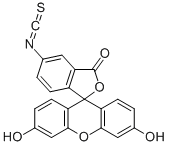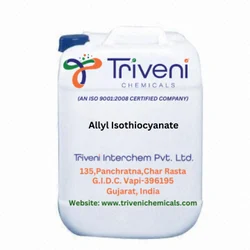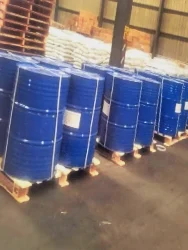Allyl isothiocyanate
Synonym(s):AITC;Oil of mustard
- CAS NO.:57-06-7
- Empirical Formula: C4H5NS
- Molecular Weight: 99.16
- MDL number: MFCD00004822
- EINECS: 200-309-2
- SAFETY DATA SHEET (SDS)
- Update Date: 2025-06-13 14:48:16

What is Allyl isothiocyanate?
Chemical properties
Allyl Isothiocyanate is the main component of mustard oil (>95%). It is a highly flammable, colorless to pale yellow, oily liquid with a typical mustard odor. Exposure to air might cause it to darken. It has a pungent, irritating smell and a bitter taste that can cause lacrimatory. It can be synthesized by reacting allyl chloride with alkaline-earth or alkali rhodanides.
Occurrence
In the essential oil from seeds of Brassica nigra Koch, Brassica juncea Hook. and Thoms., and Thlaspi arvense; in the essential oil from roots of Cochlearia armoracia; in the seeds and roots of Alliaria officinalis; in onion juice; and in the seeds of various Cruciferae. Reported found in pineapple (Anans comoscus), raw cabbage, cooked cabbage, sauerkraut, milk, heated beans, horseradish (Armoracia lapathifolia), raw cauliflower, Brussels sprouts, turnip, Chinese cabbage, wasabi (Japanese horseradish) (Wasabi japonica).
The Uses of Allyl isothiocyanate
Allyl Isothiocyanate is a synthetic flavoring agent that is a moder- ately stable, colorless to pale yellow liquid of pungent and irritating odor. it should be stored in glass containers. it is used as an artificial oil of mustard and as an imitation horseradish flavor with applica- tion in condiments, meats, and pickles at 87 ppm. it is also termed mustard oil.
What are the applications of Application
Allyl isothiocyanate is a compound which induces phase II detoxification enzymes in urinary bladder
Preparation
By distillation of sodium thiocyanate and allyl chloride
Definition
ChEBI: Allyl isothiocyanate is an isothiocyanate with the formula CH2=CHCH2N=C=S. A colorless oil with boiling point 152℃, it is responsible for the pungent taste of mustard, horseradish, and wasabi. It has a role as a lachrymator, a metabolite, an antimicrobial agent, an apoptosis inducer and an antineoplastic agent. It is an isothiocyanate and an alkenyl isothiocyanate.
Production Methods
Producted from Allyl iodide and Potassium sulfocyanide. Allyl isothiocyanate is the chief component of the volatile oil of black Mustard seed, and can be isolated by enzymatic breakdown of the glycoside in the seed.
Synthesis Reference(s)
Tetrahedron Letters, 32, p. 3503, 1991 DOI: 10.1016/0040-4039(91)80817-P
General Description
A colorless to pale-yellow oily liquid with an irritating odor. Flash point 135°F. Boiling point 300°F. Poisonous by ingestion and skin absorption. Emits toxic fumes when heated to high temperature. Insoluble in water and slightly denser than water. Hence sinks in water. Used to make other chemicals and as a fumigant. It should be stored in glass containers.
Air & Water Reactions
Flammable. Insoluble in water.
Reactivity Profile
A routine preparation by interaction of allyl chloride and sodium thiocyanate in an autoclave at 5.5 bar exploded violently at the end of the reaction. Peroxides were not present or involved and no other cause could be found, but extensive decomposition occurred when allyl isothiocyanate was heated to 250°C. in glass ampoules [Ind. Eng. Chem. 1941:19 1408].
Hazard
Extremely penetrating, pungent and stinging odor. This chemical is a powerful Iachrymator, and inhalation of its vapors may cause serious damage to human lungs. The liquid and its vapors produce blisters on the human skin. A few grams may kill a man, if the oil is taken internally.
Health Hazard
TOXIC; inhalation, ingestion or contact (skin, eyes) with vapors, dusts or substance may cause severe injury, burns or death. Bromoacetates and chloroacetates are extremely irritating/lachrymators. Reaction with water or moist air will release toxic, corrosive or flammable gases. Reaction with water may generate much heat that will increase the concentration of fumes in the air. Fire will produce irritating, corrosive and/or toxic gases. Runoff from fire control or dilution water may be corrosive and/or toxic and cause pollution.
Fire Hazard
HIGHLY FLAMMABLE: Will be easily ignited by heat, sparks or flames. Vapors form explosive mixtures with air: indoors, outdoors and sewers explosion hazards. Most vapors are heavier than air. They will spread along ground and collect in low or confined areas (sewers, basements, tanks). Vapors may travel to source of ignition and flash back. Substance will react with water (some violently) releasing flammable, toxic or corrosive gases and runoff. Contact with metals may evolve flammable hydrogen gas. Containers may explode when heated or if contaminated with water.
Contact allergens
Allyl isothiocyanate is generated by enzymatic hydrolysis of the glucoside sinigrin, present in Cruciferae- Brassicaceae, mainly the oil from black mustard seed (Brassica nigra Koch). It may induce irritant and sometimes allergic contact dermatitis, mimicking the “tulip finger” dermatitis.
Anticancer Research
This compound was tested on Ehrlich ascites tumor cells transplanted in Swissalbino mice using HEK293 cells as control. There was a significantly reduced ascitessecretion and tumor cell proliferation. Also the vascular endothelial growth factorexpression was inhibited. The apoptosis was induced in tumor cells, and cellcycle was arrested at G1 phase (Ichwan et al. 2014).
Safety Profile
Suspected carcinogen with experimental neoplastigenic and tumorigenic data. Poison by ingestion, skin contact, intravenous, subcutaneous, and intraperitoneal routes. Experimental teratogenic and reproductive effects. An eye irritant. An allergen. May cause contact dermatitis. Mutation data reported. A flammable liquid. Highly reactive. When heated to decomposition (above 250') or on contact with acid or acid fumes it emits highly toxic fumes of CN-, SO,, and NOx. To fight fire, use foam, CO2, dry chemical. See also ALLYL COMPOUNDS and ESTERS.
Potential Exposure
Used in fumigants, veterinary drugs, ointments and counter irritants, mustard plasters, and as a flavoring agent.
Shipping
UN1545 Allyl isothiocyanate, stabilized, Hazard class: 6.1; Labels: 6.1-Poison Inhalation Hazard, 3 flammable liquids.
Purification Methods
Fractionate the isothiocyanate using an efficient column, preferably in a vacuum. It is a yellow pungent, irritating and TOXIC (suspected CARCINOGEN) liquid. Store it in a sealed tube under N2. The N'-benzylthiourea derivative has m 94.5o (from aqueous EtOH) [Weller et al. J Am Chem Soc 74 1104 1952]. [Beilstein 4 IV 1081.]
Incompatibilities
Incompatible with oxidizers (chlorates, nitrates, peroxides, permanganates, perchlorates, chlorine, bromine, fluorine, etc.); contact may cause fires or explosions. Keep away from alkaline materials, strong bases, strong acids, oxoacids, epoxides, alcohols, amines
Properties of Allyl isothiocyanate
| Melting point: | -80 °C |
| Boiling point: | 151 °C |
| Density | 1.013 g/mL at 25 °C(lit.) |
| refractive index | n |
| FEMA | 2034 | ALLYL ISOTHIOCYANATE |
| Flash point: | 115 °F |
| storage temp. | 2-8°C |
| solubility | Chloroform (Sparingly), Methanol (Slightly) |
| form | Fine Crystalline Powder |
| color | White |
| Odor | at 0.01 % in propylene glycol. strong pungent mustard |
| Water Solubility | 2 g/L (20 ºC) |
| Sensitive | Moisture Sensitive |
| JECFA Number | 1560 |
| Merck | 14,295 |
| BRN | 773748 |
| Dielectric constant | 17.199999999999999 |
| Stability: | Stable. Combustible. Incompatible with oxidizing agents, acids, water, alcohols, strong bases, amines. Darkens on aging. |
| CAS DataBase Reference | 57-06-7(CAS DataBase Reference) |
| IARC | 3 (Vol. 73, Sup 7) 1999 |
| NIST Chemistry Reference | Allyl isothiocyanate(57-06-7) |
| EPA Substance Registry System | Allyl isothiocyanate (57-06-7) |
Safety information for Allyl isothiocyanate
| Signal word | Danger |
| Pictogram(s) |
 Flame Flammables GHS02  Corrosion Corrosives GHS05  Skull and Crossbones Acute Toxicity GHS06  Environment GHS09 |
| GHS Hazard Statements |
H226:Flammable liquids H302:Acute toxicity,oral H314:Skin corrosion/irritation H317:Sensitisation, Skin H410:Hazardous to the aquatic environment, long-term hazard |
| Precautionary Statement Codes |
P210:Keep away from heat/sparks/open flames/hot surfaces. — No smoking. P273:Avoid release to the environment. P280:Wear protective gloves/protective clothing/eye protection/face protection. P303+P361+P353:IF ON SKIN (or hair): Remove/Take off Immediately all contaminated clothing. Rinse SKIN with water/shower. P305+P351+P338:IF IN EYES: Rinse cautiously with water for several minutes. Remove contact lenses, if present and easy to do. Continuerinsing. |
Computed Descriptors for Allyl isothiocyanate
Allyl isothiocyanate manufacturer
New Products
4,4-Difluoropiperidine hydrochloride tert-butyl 9-methoxy-3-azaspiro[5.5]undecane-3-carboxylate Indole Methyl Resin N-Isopropylurea N,N-Dicyclohexylcarbodiimide(DCC) MELDRUMS ACID 5-METHYLISOXAZOLE-4-CARBOXYLIC ACID Magnessium Bis glycinate Zinc ascorbate 1-bromo-2-butyne 2-acetamidophenol 9(10H)-anthracenone Erythrosin B, 4-Piperidinopiperidine 2-((4-morpholinophenylamino) (methylthio) methylene) malononitrile 2,4-dihydroxybenzaldehyde 3-(4-morpholinophenylamino)-5-amino-1H-pyrazole-4-carbonitrile Methyl 2-methylquinoline-6-carboxylate 2,6-dichloro-4-nitropyridine 4-Bromo-2-chlorobenzonitrile 2-(benzylamino)acetic acid hydrochloride 4-(tert-Butoxycarbonylamino)but- 2-ynoic acid 3,4-dihydro-2H-benzo[b][1,4]dioxepine 1-Phenyl-1-cycloprppanecarboxylicacidRelated products of tetrahydrofuran








You may like
-
 Allyl isothiocyanate, 94% CAS 57-06-7View Details
Allyl isothiocyanate, 94% CAS 57-06-7View Details
57-06-7 -
 Allyl isothiocyanate 95% CAS 57-06-7View Details
Allyl isothiocyanate 95% CAS 57-06-7View Details
57-06-7 -
 Allyl isothiocyanate CAS 57-06-7View Details
Allyl isothiocyanate CAS 57-06-7View Details
57-06-7 -
 Allyl isothiocyanate CAS 57-06-7View Details
Allyl isothiocyanate CAS 57-06-7View Details
57-06-7 -
 Allyl Isothiocyanate CAS: 57-06-7View Details
Allyl Isothiocyanate CAS: 57-06-7View Details
57-06-7 -
 Allyl Isothiocyanate (57-06-7), Packaging Size: DrumView Details
Allyl Isothiocyanate (57-06-7), Packaging Size: DrumView Details
57-06-7 -
 Allyl Isothiocyanate CAS 57-06-7View Details
Allyl Isothiocyanate CAS 57-06-7View Details
57-06-7 -
 Allyl IsothiocyanateView Details
Allyl IsothiocyanateView Details
57-06-7
